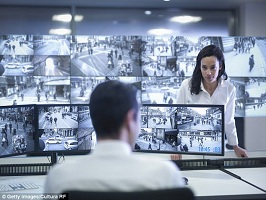A newly developed system could allow law enforcement to tap into thousands of public surveillance cameras. Created by researchers at Purdue University, the system would let officials see locations and viewing angles of the cameras used in garages, campuses, highways, and other public spaces. The developers say this could be used to increase public safety, helping law enforcement to quickly respond when necessary, and plan rescues during natural disasters or other public emergencies.
CCTVs, surveillance cameras which run within closed circuits, are only available to authorized personnel. ‘However, in recent years many organizations have deployed cameras for a wide range of purposes, and these are accessible to the public without the need for a password,’ said Yung-Hsiang Lu, an associate professor of electrical and computer engineering. ‘Although the cameras are not deployed for surveillance purposes, they can be utilized to increase public safety by properly integrating with current surveillance systems.’ The newly developed prototype builds on previous studies, using real-time streams of public network cameras, which are deployed by city and state governments in public spaces.
However, it is expected to prove controversial with experts warning that the proliferation of security cameras can invade people’s privacy. ‘We expect the number of network cameras and their coverage to grow substantially in their near future,’ Lu said. In the new system, which combines two existing systems –Visual Analytics Law Enforcement Toolkit (VALET) and Continuous Analysis of Many CAMeras (CAM2) – operators can see the visualizations of multiple data sets, including an interactive and analysis tool. The first system can show crime locations, emergency medical service runs, gang graffiti locations, calendar events, and weather, while the latter shows locations and orientations of public network cameras.
The new system integrates the public and CCTV cameras,’ said David Ebert, Purdue University’s Silicon Valley Professor of Electrical and Computer Engineering and director of VACCINE, a U.S. Department of Homeland Security center based at Purdue. The researchers have now demonstrated a proof of concept prototype. CAM2 is an open system, Lu explains, so all interested researchers can register.
‘The integrated system is based on VALET and its value can be demonstrated with two case studies.’ Lu said.








